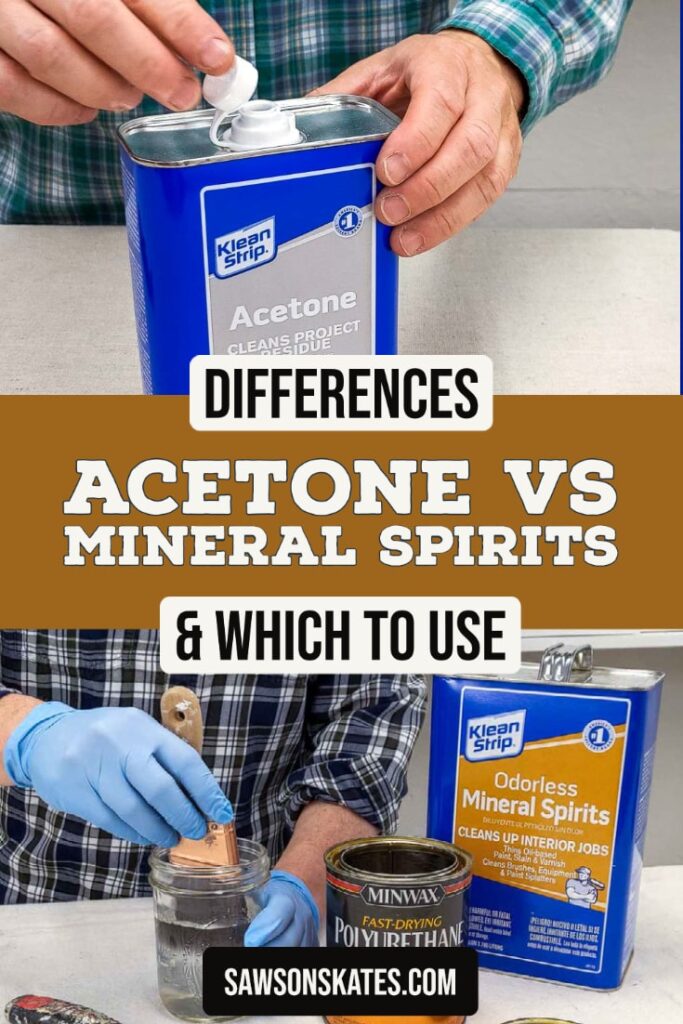Mineral Spirits vs Acetone (Differences + Which to Use)
Mineral spirits and acetone are both solvents, but what are the differences between them? I’ll break it down for you in this side-by-side comparison.
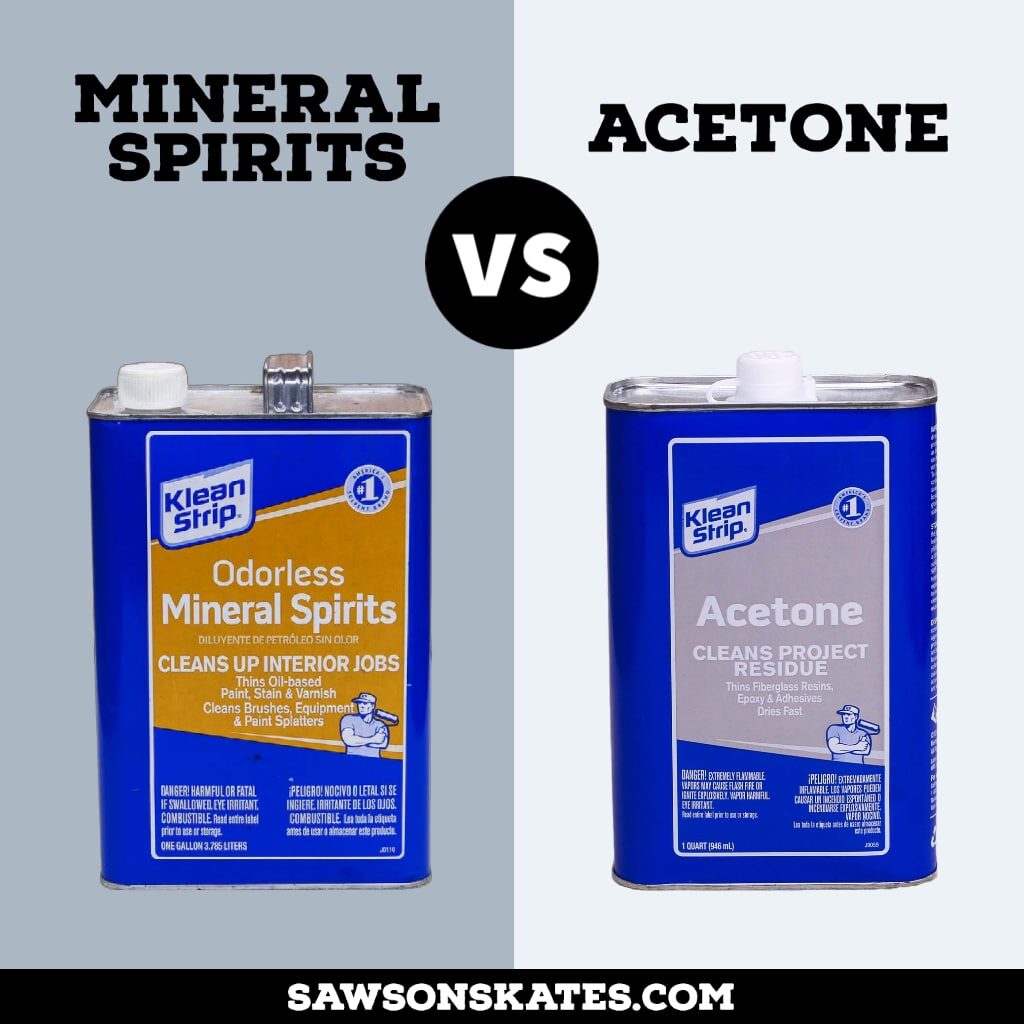
Mineral spirits and acetone are both solvents that are used for a variety of purposes. They share some similarities, but there are also key differences between them. In this article, we’ll explore the distinctions between mineral spirits and acetone, the pros and cons, and when to use each solvent so you can make an informed decision about which is best for your project.
This tutorial contains affiliate links to supplies and tools. Purchases made using these links help support the Saws on Skates website and allows me to share more projects and tips with you. There is no cost to you for using these links. Visit my site policies for more information.
Table of Contents
- What is Mineral Spirits?
- What is Mineral Spirits Used For?
- What Can You Substitute for Mineral Spirits?
- Pros and Cons of Mineral Spirits
- What is Acetone?
- What is Acetone Used For?
- What Can You Substitute for Acetone?
- Pros and Cons of Acetone
- What’s the Difference Between Mineral Spirits and Acetone?
- Mineral Spirits and Acetone Safety
- Which One Should You Choose?
- Comparison Chart
- Frequently Asked Questions
What is Mineral Spirits?
Mineral spirits is solvent derived from petroleum, a fossil fuel found beneath the ground. Gasoline, kerosene, and other substances such as mineral spirits are produced by refining it.
What is a solvent?
A solvent is a substance that dissolves another substance.
Mineral spirits is also known as white spirit, artist’s white spirit, and mineral turpentine.
Mineral spirits is frequently used as an ingredient in oil-based paints and finishes, such as polyurethane.
Related: Spar Urethane vs Polyurethane: Differences + Which to Use
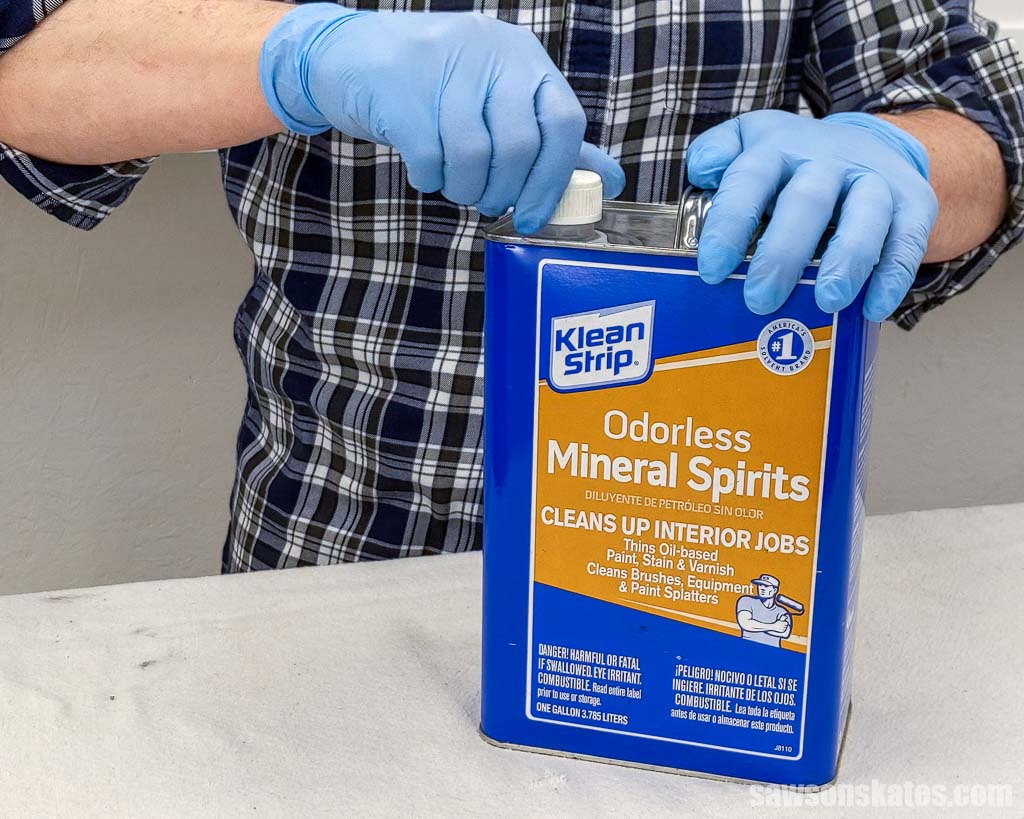
Mineral spirits is flammable, so keep it away from heat sources and flames. It also produces strong, toxic fumes that may cause headaches and irritation, so work in a ventilated area.
You can also purchase odorless mineral spirits, which have been further refined to eliminate unpleasant odors.
Unlike some solvents, mineral spirits is not water-soluble.
What are Mineral Spirits Used For?
Mineral spirits can be used for a variety of tasks, although you should use rubber gloves since it is harsh and may cause dryness, irritation, or burning on the skin.
💡 TIP: Always test it on an inconspicuous area to ensure it doesn’t harm the surface.
Thinning Oil-Based Paints, Stains, and Finishes
Mineral spirits is often used to thin or reduce the consistency of oil-based paints, stains, and top coats, making them easier to spread.
Mineral spirits is sometimes called paint thinner, although paint thinner is a variety of mineral spirits that is less refined.
Related: Mineral Spirits vs Paint Thinner (Differences & Uses)
Cleaning Paint Brushes and Other Painting Equipment
Mineral spirits can be used to clean paint brushes and other painting equipment once you’ve finished applying your oil-based paints, stains, and top coats.
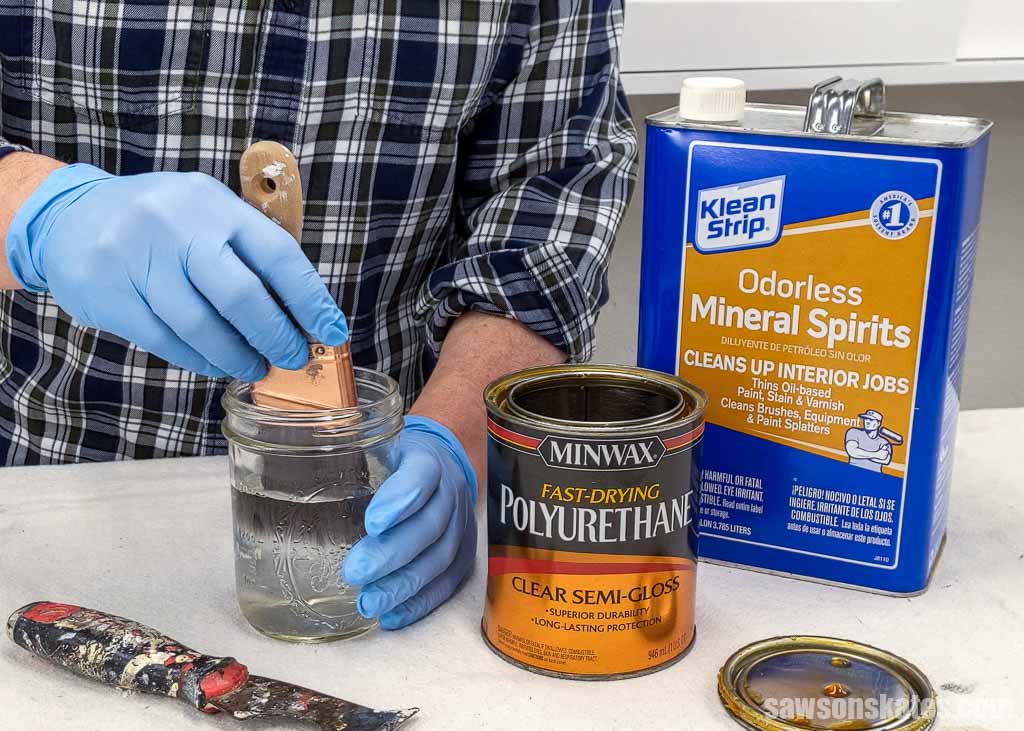
Cleaning Wood Surfaces
Mineral spirits, unlike some solvents, can be used to clean wooden surfaces like furniture and flooring because it won’t dissolve cured finishes such as polyurethane, lacquer, or shellac. To be safe, always test it on an inconspicuous area first.
⚠️ IMPORTANT: Mineral spirits should not be used on wood with a wax finish.
Degreasing Metal Surfaces
Mineral spirits dissolves petroleum-based oils and grease, allowing it to be used for cleaning metal components and equipment.
Removes Adhesives and Pine Sap
You can use mineral spirits to remove sticky residues such as pine sap and adhesives from price tags.
What Can You Use as a Substitute for Mineral Spirits?
If you don’t have mineral spirits, there are a few alternatives you can use instead.
Instead of mineral spirits, turpentine or paint thinner may be used to clean brushes and other painting equipment that have been soaked in oil-based paints, stains, or top coats.
Denatured alcohol or acetone can be substituted for mineral spirits to remove sticky residues such as labels and price tags.
Related: Denatured Alcohol vs Mineral Spirits (Differences + Uses)
Pros and Cons of Mineral Spirits
Pros
- It’s a powerful solvent that may be used to thin and clean oil-based paints, stains, and finishes.
- An odorless version is available.
- It dissolves sticky adhesives and pine sap.
Cons
- It’s flammable and should be used with caution.
- It has dangerous vapors that can cause headaches and irritation.
- It may cause skin dryness.
What is Acetone?
Acetone is a colorless, flammable liquid with a strong odor that mixes readily with water and quickly evaporates in the air. The Agency for Toxic Substances and Disease Registry says, “Acetone is a manufactured chemical that is also found naturally in the environment.”
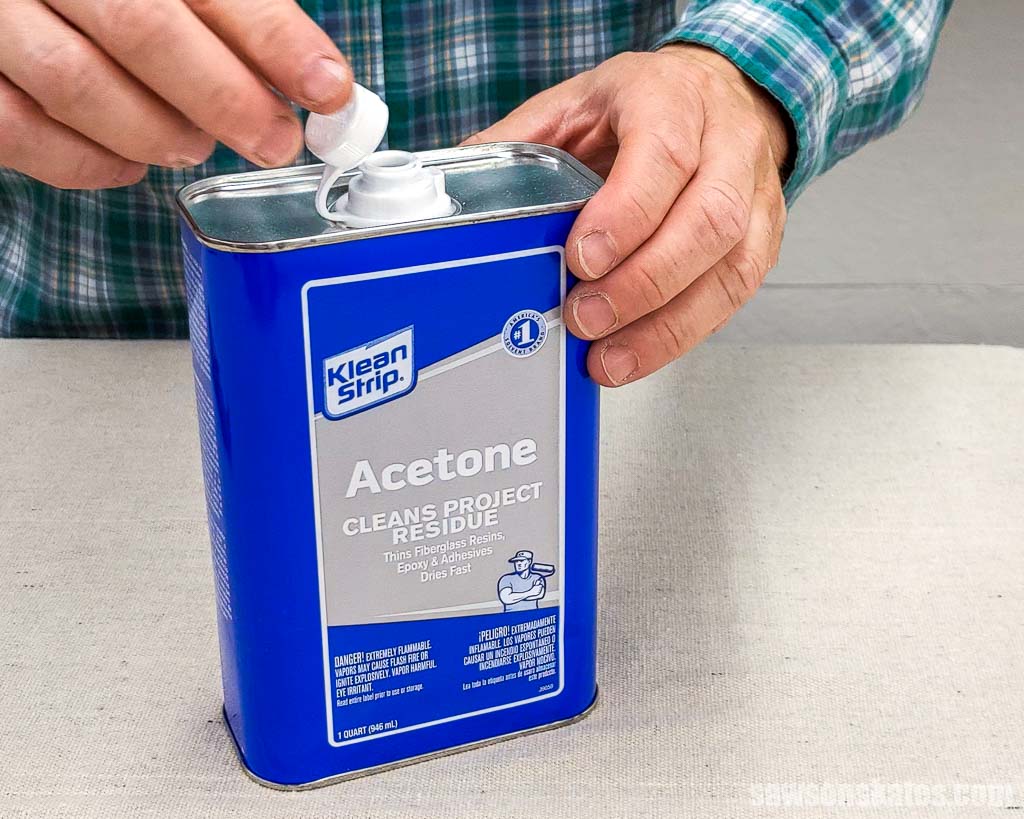
Vehicle exhaust, tobacco smoke, and landfills are all manufactured sources of acetone.
Acetone is also a naturally occurring organic compound released by plants, trees, insects, volcanic eruptions, and forest fires. It can also be found in a variety of fruits and vegetables.
Acetone is a byproduct of human metabolism, produced in small amounts by the body. Some diseases, such as diabetes, can cause these levels to rise, which can be dangerous.
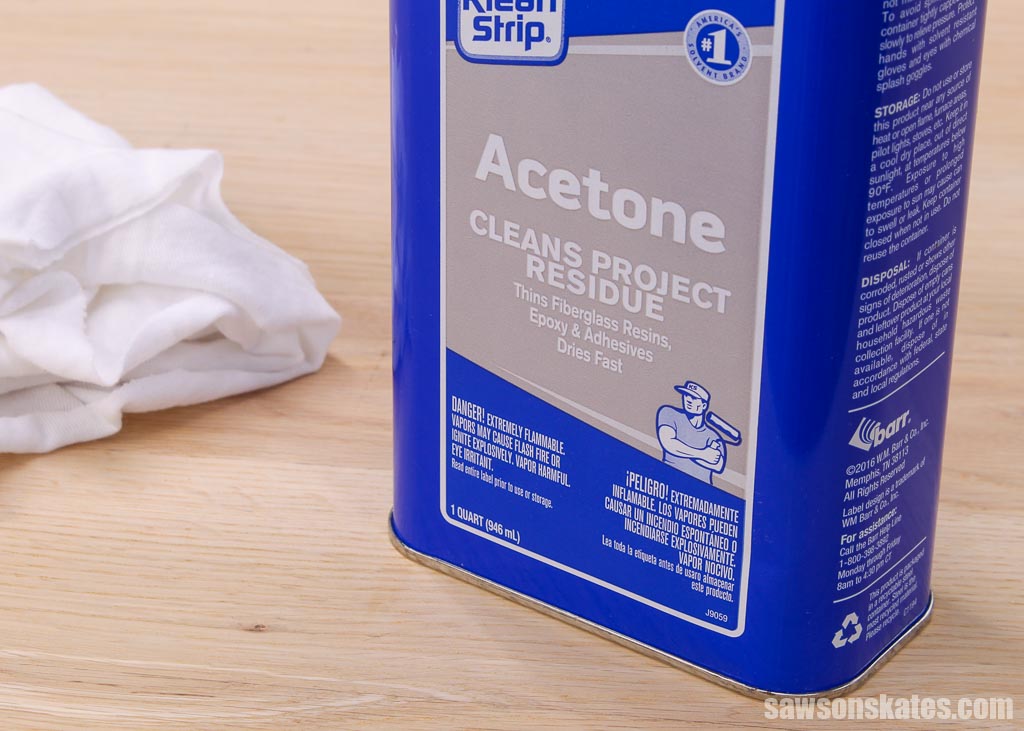
What is Acetone Used For?
Acetone is used as a solvent to dissolve other substances and to produce plastics. It’s found in nail polish remover, some types of paint thinner, and some household cleaners. It’s also used to thin polyester resins and for dissolving two-part epoxies and fiberglass resin.
💡 TIP: Be sure to test in an inconspicuous area first to prevent damaging the surrounding surface.
Nail Polish Remover
Acetone is the main ingredient in nail polish remover.
Remove Ink Stains
Acetone is also effective in removing ink stains from clothing.
Remove Scuff Marks
Acetone can also be used to remove scuff marks from floors.
Dissolve Super Glue
Acetone can dissolve super glue, making it a great way to remove it from your skin or other surfaces.
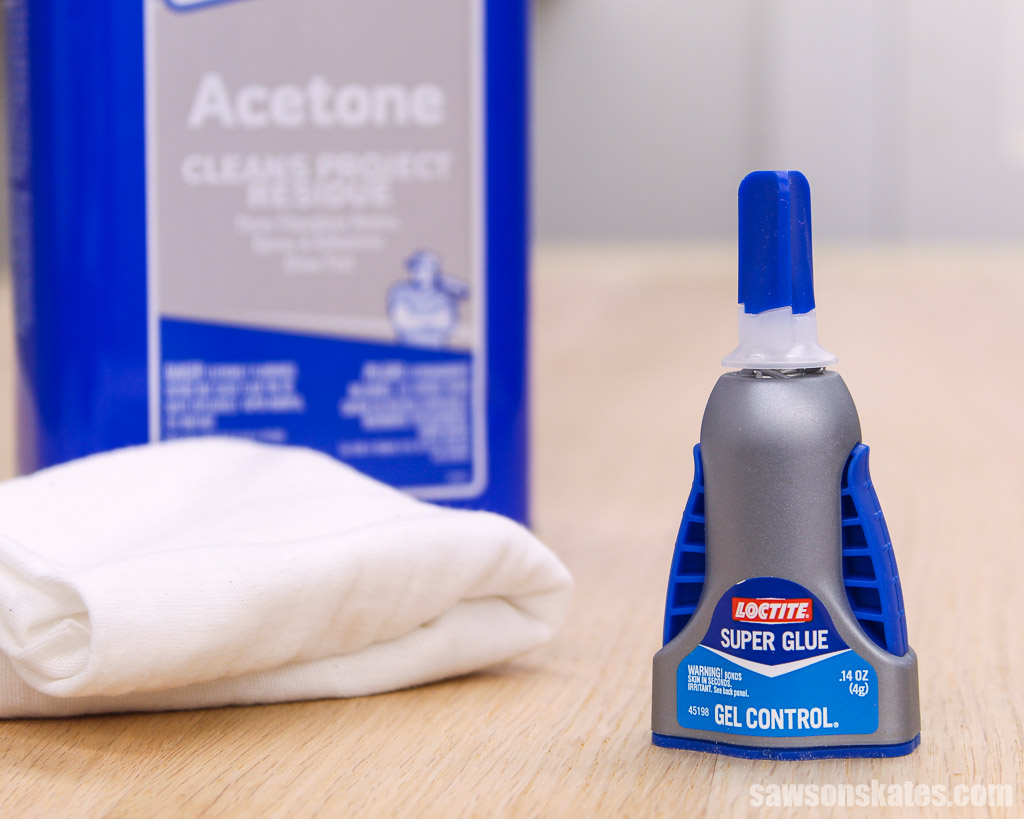
Remove Sticky Substances
Acetone can remove sticky substances such as labels and price tags.
Remove Latex Paint and Water-Based Wood Stains
Acetone can also remove dried latex paint and water-based wood stains.
Related: How to Get Wood Stain Off Skin (10 EASY Methods)
What Can You Use as a Substitute for Acetone?
If you don’t have acetone on hand, you may be able to use a few other options as substitutes.
In many cases, nail polish remover will work in a pinch. Instead of acetone, denatured alcohol can be used to remove sticky substances such as labels and price tags. Rubbing alcohol and alcohol-based hand sanitizers often work to remove ink stains.
Pros and Cons of Acetone
Pros
- Strong solvent
- Readily mixes with water and evaporates quickly
- Removes nail polish, ink stains, latex paint, scuff marks, and sticky substances such as labels and price tags
- Dissolves superglue
Cons
- Highly flammable, do not use near open flames
- It has strong fumes that may cause headaches, eye and respiratory tract irritation, and other symptoms
- If ingested, it can be toxic
What’s the Difference Between Mineral Spirits and Acetone?
Mineral spirits and acetone are both clear, flammable liquid solvents, but there are also several key differences between them.
Ingredients
The most significant difference between mineral spirits and acetone is their ingredients.
Mineral spirits is petroleum-based, while acetone is a manufactured chemical and also a naturally occurring organic compound. Acetone is released by plants, trees, and insects, found in fruits and vegetables, and even produced in small quantities by the human body.
Use as a Solvent
Mineral spirits and acetone can both be used to clean surfaces and remove sticky residue, but they differ in how they are used as solvents.
Mineral spirits are primarily used to thin oil-based paints, stains, and finishes. In contrast, acetone is used to thin polyester resins and dissolve nail polish, two-part epoxies, and super glue. Acetone is also used to remove dried latex paint and water-based stains.
Odor
Acetone has a strong, pungent odor, while mineral spirits has a smell; it’s also available in an odorless version.
Water Solubility
Acetone readily mixes with water, whereas mineral spirits does not.
Mineral Spirits and Acetone Safety
As I previously said, acetone and mineral spirits are both flammable. They should not be used near an open flame, and any equipment, rags, or other materials that come into contact with either of these solvents should be disposed of safely. Fire can result from incorrect handling.
Both of these solvents have volatile organic compounds (VOCs), which are chemicals that readily turn into vapors or gases at room temperature. They’re found in a variety of products, such as paint thinners, cleaning supplies, and pesticides.
Using these products releases VOCs into the air, where humans can inhale them. VOCs may cause nausea, dizziness, and eye irritation in people exposed to them for a short time. Long-term exposure has been linked to liver and kidney damage as well as nervous system damage.
Which One Should You Choose?
Now that you know the key differences between mineral spirits and acetone, you can decide which one is right for your needs.
Mineral spirits is a good choice for removing oil-based paint, stains, finishes, and cleaning tools such as brushes that have been soaked in them.
If you want to remove nail polish or dissolve super glue, go with acetone.
If you need to remove sticky residue such as a price tag, mineral spirits or acetone will do the trick.
Remember always to use these products in a well-ventilated area and take proper safety precautions.
Comparison Chart
| Mineral Spirits | Acetone | |
|---|---|---|
| Flammable | Yes | Yes |
| Water Soluble | No | Yes |
| Thinning Oil-Based Paints/Stains | Yes | No |
| Removing Adhesives | Yes | Yes |
| Remove Nail Polish | No | Yes |
| Dissolve Super Glue | No | Yes |
Frequently Asked Questions
Which is better acetone or mineral spirits?
The answer depends on what you’re trying to do. Mineral spirits is better for thinning or removing oil-based paint, stains, and finishes, while acetone is better for dissolving nail polish and removing super glue.
Can I use mineral spirits instead of acetone?
Yes, mineral spirits can be used in place of acetone for some applications, such as removing sticky residue. However, mineral spirits is not as effective as acetone for dissolving two-part epoxies and super glue.
Final Thoughts
Mineral spirits and acetone are both clear, flammable liquid solvents with a variety of uses. The key differences are their ingredients, uses, odor, water solubility, and odor.
When deciding which one to use, keep in mind what you’re trying to do. Mineral spirits is a good choice for thinning oil-based paint, stains, finishes, and cleaning tools such as brushes that have been soaked in them. If you want to remove nail polish or dissolve super glue, go with acetone.
Remember always to use these products in a well-ventilated area and take proper safety precautions.

